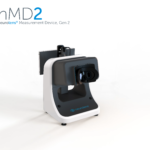Sponsored Content

By Gary Lovcik, OD
April 21, 2021
My patients are exhausted by the stress and strain of COVID-19 and the daily reality of remote working and learning. We are becoming increasingly tethered to our digital devices, and many patients are suffering from the telltale symptoms more than ever before. There are several optical products meant to address these symptoms—namely blue light-filtering substrates and anti-reflective coatings, as well as “power boost” lenses—but clinical success with these products has been limited.
Fortunately, there is a cutting-edge spectacle lens with contoured prism technology that has changed how I treat my patients; a lens technology that helps them live more comfortable and productive lives.
And now, there is a new, second-generation diagnostic tool called the neurolens Measurement Device, Gen 2—or nMD2—that I am using to prescribe this relief to my patients in an accurate, objective and repeatable way.
Technology, Patient Outcomes and Differentiation
I am an early adopter of many technologies and even helped several companies bring their products to market. In the summer of 2015, the company that would become neurolens was looking for a doctor to implement its technology for the first time. I was intrigued by the possibility that neurolens technology could help my patients complaining of migraine headaches. Shortly after implementing the technology and integrating the first-generation neurolens Measurement Device (nMD), I witnessed firsthand the dramatic difference it could make with my patients. Using the measurements obtained with the nMD to prescribe neurolenses with contoured prism allowed me to address frequent symptomology in a majority of my patients. I became the patients’ hero and my practice benefited immensely.
The neurolens system is simple to implement in any office. A lifestyle questionnaire is presented to all patients at the initial check-in. If the symptoms are significant—which is the case in about two-thirds of patients—the patient is tested using the nMD to determine the level of prism correction needed. The nMD software and algorithms utilize over 10,000 data points to arrive at these values.
 Recently, I was asked by neurolens to be a beta user for their second-generation nMD2 based on the success I have experienced with neurolens technology over the years. Like the nMD, the nMD2 is an objective, accurate and repeatable way to measure eye alignment; in fact, the state-of-the-art eye tracking system can detect phorias as small as 0.1 prism diopters. The second-generation device is also 80 percent smaller than its predecessor, with a 35 percent faster test, making it even easier to incorporate into any practice flow. Incorporating this new technology has already had a positive accelerating impact on my practice and patients.
Recently, I was asked by neurolens to be a beta user for their second-generation nMD2 based on the success I have experienced with neurolens technology over the years. Like the nMD, the nMD2 is an objective, accurate and repeatable way to measure eye alignment; in fact, the state-of-the-art eye tracking system can detect phorias as small as 0.1 prism diopters. The second-generation device is also 80 percent smaller than its predecessor, with a 35 percent faster test, making it even easier to incorporate into any practice flow. Incorporating this new technology has already had a positive accelerating impact on my practice and patients.
The improvement that neurolens technology made for my patients was impressive, with most reporting an increase in visual comfort and a decrease in headaches. I was the only eyecare provider prescribing and selling neurolenses at the time in California, so this technology also immediately became a significant practice differentiator. This technology is only available to independent eyecare providers, as it is doctor-driven and medical in nature. Retail chains are more focused on standard off-the-shelf offerings, so neurolens technology also allows for protection against retail encroachment.
Like most eyecare providers, I have always taken pride in providing visual clarity to my patients; with neurolens technology, we can also provide visual comfort, relieving symptoms that most patients don’t even realize are related to their sight. By treating patients in this holistic way, they become lifetime patients, grateful for the impact you have made to their overall quality of life through comprehensive vision care. I currently have well over 1,000 patients wearing neurolenses in my practice; and patient satisfaction is so high that 98 percent of patients reorder their neurolenses. In short, neurolens technology is enabling a level of patient care in my practice that differentiates me from my competition.
Impressive ROI, Even During a Pandemic
Of the many technologies I have adopted in my practice, neurolens technology has resulted in the highest return on investment. In 2016, my practice’s first full year with neurolens technology, we added 18 percent to our per patient gross revenue. Since I adopted neurolens technology in September 2015, I have grossed over a half million dollars in incremental revenue attributed to neurolenses alone. While I continued to experience steady growth in the intervening years, the events of 2020 contributed to an historic year of growth for my practice.
Learn More
In the last several months, I have started using the terms “Zoom Fatigue” and “Zoom Doom” in patient conversations, and these concepts immediately resonate with them. These terms of course refer to the more commonly known Digital Vision Syndrome or DVS. Based on a study from the Vision Council, over 65 percent of Americans experience symptoms of DVS on a daily basis, and we now know that these symptoms are commonly caused by misalignment of the eyes. Lenses or coatings with blue light filters have been a popular solution, but they provide little symptom relief. Wearing neuroleses, however, has been shown to provide 80-90 percent symptom relief (depending on the symptom), even in patients with 1 prism diopter of correction or less.
Despite being closed for six weeks in 2020, my office experienced 20 percent growth in per patient gross revenue and 10 percent overall revenue growth, both records for the practice. One of the primary reasons for that success was prescribing more neurolenses in 2020 than I had in previous years. The ubiquitous nature of remote working and learning has caused symptomology to rise dramatically in my patient base. More patients are struggling with DVS and are highly motivated to find a solution, which I am able to confidently provide.
Read More Success Stories
The Practice & Profitability Builder that Keeps Giving
I explain to colleagues that the key to practice growth is to offer a diverse portfolio of services to your patients. The core of optometric care (glasses and contact lenses) is being lured to outside sources. Creating strong reasons for a patient to return to your practice is paramount to a practice’s success. Unique product and service offerings, such as the nMD2 and neurolenses, have benefited my practice and patients tremendously. This technology has given me a way to greatly enhance care while providing services that can’t be taken away by online retailers or big-box optical stores.
Partnering with neurolens has allowed me to provide a much-needed visual and pain reduction solution for patients while propelling practice growth and profitability. But what I love most about neurolens is that I get to become a hero to my patients, not just another doctor spinning dials.
 Gary Lovcik, OD, is the owner of Anaheim Hills Optometric Center in Anaheim, Calif. To contact him: LovcikOD@yahoo.com
Gary Lovcik, OD, is the owner of Anaheim Hills Optometric Center in Anaheim, Calif. To contact him: LovcikOD@yahoo.com





















